Reading Comprehension Text and Exercises
Cairo
The City of Contrasts
The official name of Cairo, the capital of Egypt, is al-Qahirah, which in Arabic means "the Conqueror" or "the Victorious". A legend suggests that when this North African megacity was founded, "the Conquering Star" (an-Najm al-Qahir in Arabic), another name for the planet Mars, was rising in the sky. Such a powerful name suits this inspiring city on the Nile River.
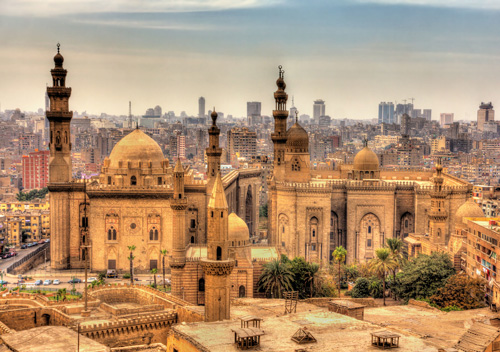
Click Here for Step-by-Step Rules, Stories and Exercises to Practice All English Tenses
A Brief History of Cairo
- Situated on the Nile, the site of Cairo had a strategic value for Ancient Egypt. Archaeological ruins show that the ancient capital of Memphis was located nearby.
- In the 4th century, the Romans built a fortress called Babylon along the east bank of the Nile. This fortress is the oldest structure in Cairo today.
- As Muslim forces took over many territories in the region, they established a settlement north of Babylon. The settlement, called al-Fustat, became the first capital of Islamic Egypt.
- One of the Islamic dynasties, the Fatimid dynasty, wished to build a new capital for themselves in 969 AD. The capital, which we today know as Cairo, quickly grew to be the center of learning, having had a library with hundreds of thousands of books.
- Over the next few centuries, Cairo expanded so much that it grew to have a population of half a million people in 1340, which made it the largest city west of China. At that time, Cairo was at the crossroads of the famous spice trade route where people from Africa, Europe, and Asia met.
- Today, Cairo is the city of contrasts. The city's landscape includes tall skyscrapers as well as ancient pyramids.

Al-Azhar Mosque
The Al-Azhar Mosque is as old as Cairo. The then-ruling Fatimid dynasty had ordered its construction and dedicated it in 972. Already in 989, thirty-five scholars were hired to teach at the mosque, which makes it the second oldest university which still runs today.
The University of Al-Azhar remained the foremost institution for studying Islamic law and theology for 1,000 years until it was turned into an independent, non-religious school in 1961.
It is not certain why the mosque is called Al-Azhar. One explanation could be that azhar is the masculine form of zahra, which means "splendid". Zahra was also a name often associated with Fatimah, the daughter of Muhammad, the central figure in Islam.
The mosque has seen many rulers and occupying forces during its long history, some of whom have expanded it by adding minarets (towers) and gates.
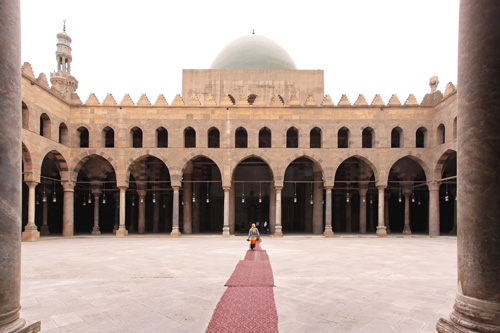
Giza Pyramid Complex
On the outskirts of Cairo lies the only remaining wonder of the Ancient World, the world famous pyramids of Giza. There are three pyramids which have survived for 4,500 years since they were originally built as monumental tombs for Egypt's pharaohs (leaders).
The ancient Egyptians believed that their pharaohs became gods after they had died, so these massive pyramids were supposed to provide them with all the things they might need in the afterlife (for example, food or gold). The largest one of them, known as the Great Pyramid, is made of 2.3 million individual stone blocks, each of them weighing 2.5 to 15 tons.
Besides the pyramids, the Giza complex also includes the Sphinx, an enormous monument of a creature which has the body of a lion and the head of a pharaoh. The Sphinx represents the Pharaoh Khafre, who ordered the construction of the second pyramid.
We know that no pyramid could have been built without the tireless work of thousands of workers, we do not know exactly how many were employed. Herodotus, an ancient Greek historian, reported hearing that 400,000 people built the Great Pyramid in 20 years.
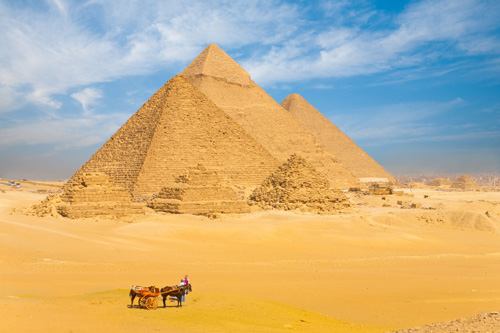
Citadel
The Saladin Citadel in Cairo was founded as a fortification in the 12th century on a hill near the city center. It was built to protect the city from the Crusaders, warriors who wanted to spread Christianity.
Many people and animals lived in the citadel, and they were able to have enough water supplies thanks to the Well of Joseph, a 280 feet (85 meters) deep well which was connected to the Nile River.
Citadel was also the center of Egyptian government until the 19th century, after which it was used for military purposes. More specifically, it served as a barrack for British forces during World War II.
Today, it is a popular monument, with several mosques and museums. The three main mosques were constructed during different periods, so they are nice locations for everyone who feels curious about Cairo's history.
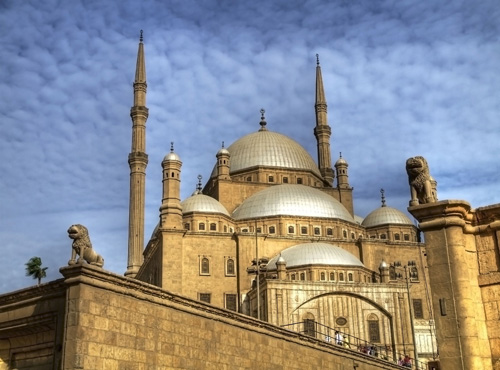
Things To Do in Cairo
- The Nile River is the second longest river in the world. While in Cairo, use the opportunity to take a ride in a felucca, a traditional wooden boat, along the river, and enjoy the wonderful sights of the city.
- Egypt has for a long time been known for colorful spices and strong coffee. The get the best taste of this aspect of Cairo, visit the busy market of Khan el-Khalili. Bargaining is very welcome!
- Camel-riding used to be a much more popular means of transportation before than it is today, but all interested tourists are still able to try it out. The best way to do it is to ride through the desert around the Giza pyramids complex.
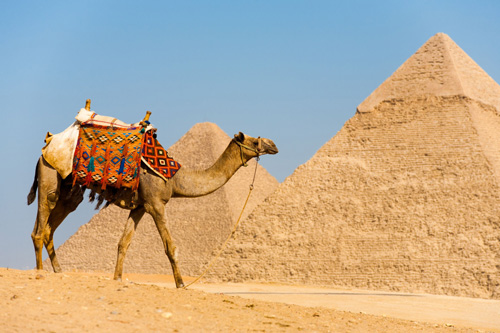
Comprehension Exercises
Vocabulary Questions
- What does "foremost" mean?
- having a promising future
- standing in front of something
- most important, leading
- What does "victorious" mean?
- having won
- having lost
- being associated with someone called Victor
- What does "tireless" mean?
- working energetically and continuously
- a vehicle without any tires
- feeling constantly tired
- What does "barrack" mean?
- place where parties are thrown
- building where soldiers are accommodated
- military hospital
- What does "bargaining" mean?
- paying with golden coins
- offering to work for free
- negotiating a trade, trying to lower the price
Collocation Questions
- You probably feel __________ about Egypt's history.
- puzzled
- curious
- nosy
- The Romans built a fortress along the east __________ of the Nile River.
- border
- rim
- bank
- Tourists are recommended to try __________ camel-riding.
- out
- of
- in
- Muhammad is the central __________ in Islam.
- person
- figure
- identity
- The pyramids were built thanks to the __________ work of thousands of workers.
- forceful
- tireless
- dynamic
- The site of Cairo had a great strategic __________.
- merit
- benefit
- value
- Cairo was at the crossroads of the spice trade __________.
- course
- route
- passage
- Cairo quickly became the __________ of learning.
- spot
- point
- center
- Muslim forces took __________ many territories in the region.
- over
- out
- away
- To get the best __________ of Cairo, visit Khan el-Khalili.
- flavor
- taste
- smell
Wh Questions
- How did the residents of the Citadel get water?
- directly from the Nile River
- from the Mediterranean Sea
- from the Well of Joseph
- Where was the ancient capital of Memphis located?
- in the Citadel
- close to Cairo
- It is unknown.
- Who were the pyramids built for?
- residents of Cairo
- the god of the sun
- pharaohs
- Why did Cairo quickly become the center of learning in the 10th century?
- because people came to learn about the pyramids
- because it had a large library
- because many smart people lived there
- What are feluccas?
- boats
- cheese pies
- camels
Evaluating Statements
- Based on the information in this lesson, which statement is true?
- The Sphinx is half-lion, half-human.
- The Sphinx is half-bird, half-human.
- Based on the information in this lesson, which statement is false?
- The Al-Azhar Mosque might have been named after Fatimah.
- Muhammad's daughter Fatimah built the Al-Azhar Mosque.
True or False?
- Based on the information in this lesson, is the following statement true or false?
"The city of Cairo is as old as the Giza pyramids." - True
- False
- Based on the information in this lesson, is the following statement true or false?
"In the 14th century, Cairo was one of the largest cities in the world." - True
- False
Answer Key
1. C | 2. A | 3. A | 4. B | 5. C | 6. B | 7. C | 8. A | 9. B | 10. B | 11. C | 12. B | 13. C | 14. A | 15. B | 16. C | 17. B | 18. C | 19. B | 20. A | 21. A | 22. B | 23. B | 24. A
Get Updates, Special Offers, and English Resources
Download your FREE GIFT (the first two chapters of
English Short Stories Book and Workbook)
as soon as you join!

By submitting your email, you consent to receiving updates and newsletters from us and to the sharing of your personal data with third parties for the purposes of sending you communications. We will not spam you. You can unsubscribe at any time. For more information, please see our privacy policy.





